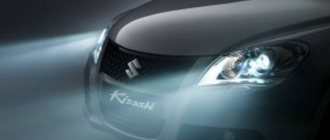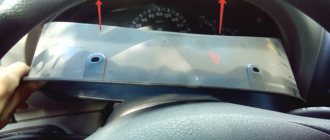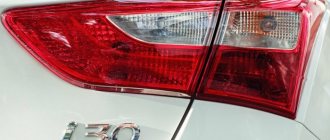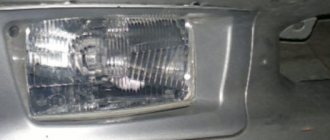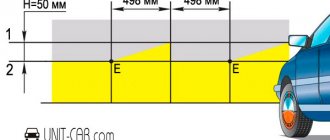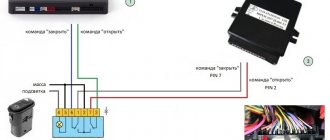Is it worth changing xenon to halogen - advantages and disadvantages
Before addressing this issue, let's find out how xenon differs from halogen. First of all, the principle of operation is completely different for these lamps. A halogen lamp is essentially a regular incandescent light bulb. It has the same spiral (incandescent body) as the Ilyich light bulb. The current heats up this spiral, and it begins to glow brightly. The spiral is protected from oxidation by a flask filled with an inert gas.
The only difference between a halogen and a regular one: a halogen - bromine or iodine - is added to the gas filling the flask. It “knows” how to capture evaporated tungsten molecules and return them back to the spiral. As a result, the service life of the device increases and allows the filament body to be heated to a higher temperature. This increases light output and makes the emission spectrum as close as possible to natural daylight.
Automotive halogen lamp
The difference between a halogen lamp and a regular lamp is also in the material of the bulb. For the first, the operating temperature is so high that ordinary glass will simply melt. Therefore, the halogen flask is made of refractory quartz glass.
A xenon light bulb is a gas-discharge device. It does not have a spiral, but is equipped with two electrodes. When operating voltage is applied to the electrodes, the gas itself that fills the flask begins to glow. This significantly increases light output and efficiency with the same power as halogen light sources.
Car xenon lamp
But if xenon is brighter and shines better, why change it to halogen? To understand this issue, let’s determine the advantages and disadvantages of both devices.
Advantages and disadvantages of halogen and xenon lamps
| Halogen | Xenon |
| Bulbs can be changed one at a time | If one bulb burns out, both must be replaced to maintain the same light output from the headlights. |
| Can work directly from the vehicle's on-board network | A special driver is required - a high-voltage converter and ignition system |
| Easy installation | Installation and installation are quite complicated |
| Does not require expensive and complex optics. Usually a simple headlight with a reflector is enough | Requires a special optical system designed specifically for this type of lamp |
| Average light output | Good light output |
| The use of halogen is permitted on almost all modern cars with standard headlights | The installation of non-standard xenon entails administrative liability in the form of deprivation of rights for up to a year. It is impossible to pass a technical inspection. |
| Relatively low cost | Unreasonably high cost, aggravated by the fact that devices need to be replaced in pairs and additional costs are possible if the ignition unit fails |
Expert opinion Alexey Bartosh Specialist in repair and maintenance of electrical equipment and industrial electronics. Ask an expert a question So, according to the table, xenon is full of shortcomings and problems. But halogen lights have only one drawback - lower light output. Thus, replacing xenon with halogen is completely justified in most cases.
Comparison of the cost of xenon lamps and conventional ones
In order not to be unfounded, let’s compare the real cost of halogen and xenon lamps from different manufacturers.
Halogen:
- Philips HB3 BlueVision 12V 9005BV (1 piece) – 750 rub.;
- Osram Cool Blue Intense H4 12V 64193CBI-HCB DUO (2 pcs.) – 650 RUR;
- Osram Silverstar H7 12V 64210SV2-01B (1 pc.) – 350 rub.;
- Osram Original H4 1V2 64193-01B (1 piece) – 150 rub.
Xenon:
- Philips X-tremeVision Gen 2 D4S, without ignition unit (1 pc.) – RUB 5,300;
- Osram XENARC ORIGINAL, 35 W, D1S, with ignition unit (1 pc.) – RUB 3,500;
- Philips Xenon Vision 85126VIC1, D2R, without ignition unit (1 pc.) – RUB 2,400;
- ClearLight Xenon Premium +150%, without ignition units (2 pcs.) – RUB 1,690.
Thus, the average cost of xenon is approximately 10 times higher than the cost of a halogen light source. Let's add here the prices for ignition units, which also break, and the fact that xenon must be replaced in pairs, even if one bulb has burned out.
Which halogen lamps shine like xenon
Typically, xenon lamps have a cooler, bluer light than halogen lamps. Is it possible to get the same effect with halogen? It turns out that it is possible. It is enough to do a little tuning - buy a halogen light bulb with a blue bulb and the Blue marking, we have given examples of such lamps above (Osram Cool Blue Intense , Philips BlueVision, etc.).
Halogen lamps for xenon
What are the advantages of halogen lamps
Although the halogen lamp has less illumination, it still has a number of advantages over the xenon lamp:
- First of all, the lighting device has a lower cost. The average price for a xenon lamp is more than 1,000 rubles. You can purchase devices at a lower cost, but in this situation the quality of the lamp and its service life are not guaranteed by the manufacturer (for example, Chinese xenon);
The cost of halogen lamps averages 150 rubles and more. The cost is influenced by such factors as: lamp power, manufacturer company, and so on.
- replacement of xenon lamps is carried out in a complex manner, that is, if one lamp burns out, both lighting devices will have to be changed, since when replacing one lamp it will not be possible to achieve the desired level of illumination, and the lamps themselves, which have the same parameters, may differ in color and declared power;
Halogen lamps can be replaced individually and this aspect will not affect the quality of roadway lighting.
- halogen lamps can be installed independently, while xenon replacement is carried out by specialists, since an additional connection to the device is required;
- there is no administrative liability in the form of deprivation of rights for the installation of halogen lamps;
- The average lifespan of a halogen-based lamp is 400 hours of continuous operation. The most significant disadvantages of halogen over xenon are the low degree of illumination and the adhesion of dirt to the headlight due to the high heating of the outer surface.
Replacement process
If xenon lamps were installed in violation of all standards in halogen headlights, then replacement is extremely simple and boils down to the following:
- Remove one terminal from the battery.
- We disconnect the ignition unit from the vehicle’s on-board network and the xenon lamp.
- Remove the light bulb from the headlight.
- Completely remove the ignition unit.
- We install halogen lamps of the type and base that should be standard in these headlights.
- If the standard socket has not been modified, then simply put it on the light bulb base.
- If the block has been replaced or is missing altogether (“homemade ones” have been modified), then you will have to purchase it and connect it yourself to the on-board network wires that were previously connected to the ignition unit.
Connection diagram for halogen instead of xenon
When installing the block yourself, you do not need to observe polarity. Halogen lamps do not care at all where the positive and negative wires are.
If xenon was installed together with headlights specifically designed for it, then the process becomes somewhat more complicated and will cost more. You will have to remove not only the ignition unit with the lamp, but also the headlight itself, and in its place install a “native” one, that is, a halogen one, provided for by the design. The differences lie in the design of the reflectors.
We will not consider the question of how to change headlights, since the procedure for each make and model of car is different. Otherwise, this option of replacing xenon with halogen is no different from the previous one.
Expert opinionAlexey BartoshSpecialist in the repair and maintenance of electrical equipment and industrial electronics.Ask a question to an expertIt is impossible to install halogen in xenon headlights without serious modification by a specialist - the cut-off line will be violated, and our car will dazzle oncoming people more than illuminate the road!
Well, the last mandatory operation is adjusting the headlights, which can be done at any service station or independently by adjusting the position of the light fixtures using a corrector or special adjustment screws.
So we found out how to replace xenon lamps with halogen ones and whether it is worth doing it at all.
What is LED
Pros of LEDs
The absence of a filament and moving parts makes it reliable and resistant to mechanical stress; there is almost nothing to break.
In addition, they are not afraid of low temperatures. The first generations of LEDs had a weak luminous flux. Nowadays third generation diodes are used. If they have a special stabilization unit (driver), they are capable of emitting a luminous flux almost equal to xenon. The energy consumption of LEDs is lower than that of xenon or halogen, which means there is virtually no load on the generator. Installation of diode lamps is simple and does not require modifications to the headlight. They come in all sizes - from H1 to H11, and the driver unit fits inside the case. The light bulb replaces the standard one; you just need to bite off the power connector and connect it to the wire going to the block. According to personal feelings, the luminous flux of an LED lamp is stronger than conventional halogen lamps. Visually, it is almost no different from xenon in terms of brightness, but practically does not dazzle. The light from the diodes is soft and slightly diffused, illuminating the space in front of the car well. This will help in bad weather conditions - fog or rain. I chose xenon lamps, like LED lamps, with a color temperature of 5100K. It is a soft white color with a blue tint. The price of a set of two LED bulbs is comparable to a similar set of gas-discharge lamps. I purchased a set from S7, size H1, for $30 on Aliexpress.
Cons of LEDs
For what reasons should xenon lamps be replaced in pairs?
It is generally accepted that there are no fundamental differences between a xenon and halogen lamp. This is a wrong point of view. However, the majority, with enviable consistency, continue to change the xenon lamp one at a time (by analogy with the halogen lamp).
In order to understand this issue, you need to understand the technology for generating light in these lamps.
Tungsten filament is the main light source in a halogen lamp. During operation, such a thread has a constant glow intensity and does not require additional operating resources (if the wear of the spiral is not taken into account).
Due to identical electrical characteristics, when replacing one halogen lamp with another, the intensity of the glow will not change.
A xenon lamp, unlike a halogen lamp, does not have an incandescent filament in its design, and inert gases act as a source of glow.
Here is a clear concrete example of a burnt-out xenon lamp:
Additional requirements for xenon headlights
According to the instructions, xenon headlights must be equipped with high-pressure washers. This requirement is not due to the fact that dirty windows transmit less light, but because through dirty windows, due to optical laws, light blinds oncoming drivers more than through clean ones.
In addition to the washer, the requirements of the current technical regulations at the time of its appearance required the presence of an automatic headlight leveler, capable of changing the height of the light beam depending on the terrain and vehicle load. An incident arose due to the fact that cars of the 90s in top trim levels were often equipped with xenon headlights with a mechanical corrector or without a corrector at all. In this regard, after disputes and debates, changes were made to the current GOST R 51709-2001 dated June 23, 2009, and the mandatory requirement for an automatic corrector (clause 4.3.2.2.) was excluded. Accordingly, if there are the necessary markings on the glass, the inspector does not have the right to demand the presence of a proofreader.
What should those who install xenon themselves do? An automatic corrector is a complex electronic-mechanical unit, and it can only be installed in a specialized technical center, but the project budget will increase significantly, making the alteration pointless.
Thus, installing xenon in headlights, without violating the current rules, is possible only by replacing the lamps with used (or new) headlights with “xenon” markings on the glass, and only if such headlights were installed on cars similar to yours. For example, products from the Volzhsky Automobile Plant have never been produced with xenon headlights.
If you convert the headlights to xenon, even by installing special lenses, the current legislation will be violated, although oncoming drivers will not be blinded by the headlights of your car if they are set correctly.
What happens when a xenon lamp glows?
During operation, the structural composition of inert gases undergoes changes, it degrades, as a result of which two physical phenomena are observed:
— decrease in the intensity of the luminous flux (the brightness of the lamp becomes less);
— the color temperature threshold increases, as a result of which the lamp acquires a “cold” glow.
Thus, we have to state a disappointing fact: any newly installed xenon lamp will shine noticeably brighter than the old one. You can verify this in the dark on the open road, or by visiting a car service center and experimenting on a stand.
In addition, the hue of the xenon lamp that has been in use is “colder” than that of a newly installed one.
That is why, in order to ensure uniform luminous flux intensity, it is recommended to change xenon lamps in pairs rather than one at a time.
According to the observation of experienced specialists, already 3 months after replacing a single lamp, a contrasting glow can be observed.
It is necessary to understand that the reliability and average service life of xenon lamps are approximately the same, so there will be no significant benefit in replacing only a single product.
On many modern vehicles, in order to replace the lamp, it is often necessary to remove the bumper, which imposes certain labor costs. Keep this in mind when you want to save money, you will replace only one product instead of a pair.
Comparative table of glow temperatures of xenon lamps:
The German-made Philips d2s xenon lamp has proven itself well on the automotive market.
EFC › Blog › How to properly replace halogen headlights with xenon
Brightness depends on the lamp power and the angle of radiation.
The interior light sensor is faulty." I tell them: “I covered it with duct tape, tear it off.”3. The technician calls: “The sensor is OK - the body position sensors are faulty.” I say: “There are no errors in self-diagnosis.” He says: “They show errors on diagnostic equipment.”
Since halogen lamps are weaker than xenon lamps, their light is concentrated in a narrow beam.
This allows you to direct all the radiation power in one direction. If you install xenon lamps in headlights with reflectors under halogens, the light beam will remain the same as it was before, and the radiation power will increase. The headlights will begin to blind drivers of oncoming cars. In addition, the beam of light from both headlights (this is especially noticeable in the case of using halogen lamps) has a clear border at the top, the so-called “daw” (a dark border shaped like the unfolded wings of a bird). Officially, the dividing line illuminated and unlit areas is called the cut-off boundary (CTB).
The correct location of the height of the STG is achieved not by adjustments, but constructively - due to the shape of the reflector and through the use of a curtain limiting the light beam, and in the case
We recommend reading: Request about the nature and conditions of work activity of a person sent to ITU
What is a xenon lamp
Such lighting products are usually sold in the following configurations:
- Two lamps.
- Two blocks to connect lamps.
- Contact wires.
- Means used for fastening.
- Instructions describing installation.
A xenon lamp is a cylindrical glass bulb with an incandescent arc placed inside, surrounded by a noble gas of natural origin - xenon. This gas, exposed to a strong discharge of current, changes its state to plasma and begins to emit strong light.
Since the pressure in the flask is quite significant, ordinary glass is not suitable for its manufacture, so quartz, sapphire or ceramic are used, provided that their strength is at a high level.
Xenon in a standard headlight is of no use!
Stopped for xenon
? What to do? Save your nerves, time, money and keep your driver's license. It also has something to do with it - over time, the performance characteristics of the electrical elements of ignition units (especially those made in China) change significantly. Moto beauty and if you install an ssd? How to remove xenon and install regular lamps. For example, the notorious capacitors of doubtful condition will partially or completely lose their nominal capacity.
How the malfunction manifests itself is the burnout of one of the electronic switching keys for the external lighting control microcircuits. In the case of “xenon in the low beam” - a constantly glowing turn signal, either right or left. An example can be seen in the photo.
In the case of xenon in PTF, there is a constantly glowing fluorescent lamp either on the right side or on the left.
What to do if the xenon is already installed and the unit is still working. Refuse the non-standard one, dismantle it if possible and look for a guaranteed standard one, which may not be cheap. As an alternative option, abandon the “Chinese” ignition units in favor of low-voltage units from well-known manufacturers - for example, Hella.
Now to the LEDs
